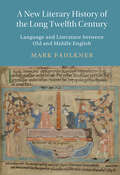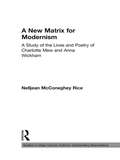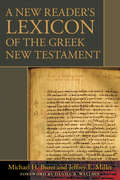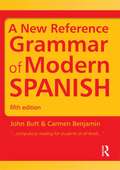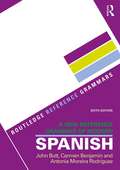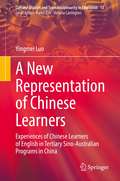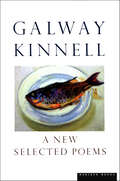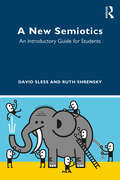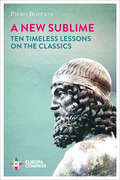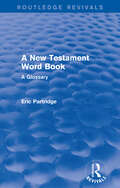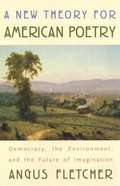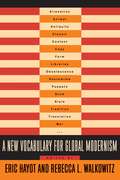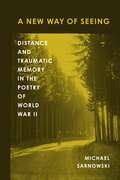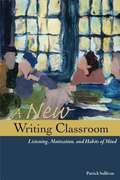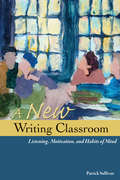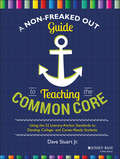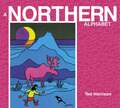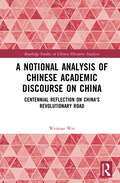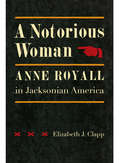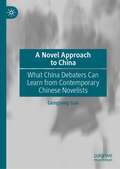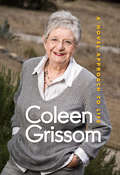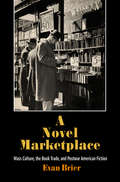- Table View
- List View
A New Literary History of the Long Twelfth Century: Language and Literature between Old and Middle English (Cambridge Studies in Medieval Literature #118)
by Mark FaulknerA New Literary History of the Long Twelfth Century offers a new narrative of what happened to English language writing in the long twelfth century, the period that saw the end of the Old English tradition and the beginning of Middle English writing. It discusses numerous neglected or unknown texts, focusing particularly on documents, chronicles and sermons. To tell the story of this pivotal period, it adopts approaches from both literary criticism and historical linguistics, finding a synthesis for them in a twenty-first century philology. It develops new methodologies for addressing major questions about twelfth-century texts, including when they were written, how they were read and their relationship to earlier works. Essential reading for anyone interested in what happened to English after the Norman Conquest, this study lays the groundwork for the coming decade's work on transitional English.
A New Matrix for Modernism: A Study of the Lives and Poetry of Charlotte Mew & Anna Wickham (Studies in Major Literary Authors)
by Nelljean RiceMany studies of poetic modernism focus on the avatars of High Modernism, Eliot, Pound and Yeats, who created a critical coterie based on culture and class. A New Matrix for Modernism introduces a matrilineage for modernism that traces a distinct women's poetic voice from the Bronte sisters through Alice Meynell to modernists Charlotte Mew and Anna Wickham who combine feminist content with an innovative exploration of formalist prosody. Shifting emphasis from woman to child, mother to daughter, and urbs to suburb, relocating modernism's matrilingua to the boundaries of London society and culture, A NewMatrix for Modernism ranges widely among architecture, mental illness, Fabianism, Positivism, Theosophy, women's suffrage and education to a new house for modernism-a woman's place of secret joys and sorrows. Well researched yet passionate, this book will appeal to both the scholar and the generalist interested in modernism, poetry, feminism, culture and British literary history.
A New Reader's Lexicon of the Greek New Testament
by Michael H. Burer Jeffrey E. Miller"What Kubo did for the last generation, Burer and Miller's A New Reader's Lexicon will do for the next."-from the foreword by Daniel B. WallaceImproving on earlier lexical works, A New Reader's Lexicon of the Greek New Testament incorporates all words that occur fewer than fifty times in the New Testament. In canonical order, it catalogs a word's frequency in each book,in each author's writings, and in the entire New Testament. References to rare or noteworthy word usages are included, allowing the reader to quickly identify words of special significance."This lexicon . . . has overcome the noticeable shortcomings of Kubo and should well serve the person who wants to keep up their Greek by daily reading, but gets frustrated by having to spend so much time looking up words." -Gordon D. Fee Professor of New Testament Studies Regent College"A New Reader's Lexicon is a step forward for the student of Greek and is sure to be of benefit to those who teach Greek. . . . The use of A Greek-English Lexicon of the New Testament and Other Early Christian Literature (BDAG) is a great touch."-Darrell L. Bock Research Professor of New Testament Studies Dallas Theological Seminary"Very usable, exceedingly helpful, and a fine contribution to any student of the Word interested in serious reading of the Greek New Testament."-Grant Osborne Professor of the New Testament Trinity Evangelical Divinity School
A New Reference Grammar of Modern Spanish
by Carmen Benjamin John B. ButtFor many years A NEW REFERENCE GRAMMAR OF MODERN SPANISH has been trusted by students and teachers as the standard English-language reference grammar of Spanish.Now updated to include the latest findings of the Royal Spanish Academy's official grammar book, 'La Nueva gramática de la lengua española', making A NEW REFERENCE GRAMMAR OF MODERN SPANISH FIFTH EDITION even more relevant to students and teachers of Spanish.Key features of this fifth edition include:a 'Guide to the Book', enabling you to make the most of this new editionnew vocabulary such as topical and technological terms, bringing you up-to-date with contemporary spoken Spanishmore Latin-American Spanish, ensuring world-wide coverageaclearer guidance to recommended usage-advice on the Academy's latest spelling rules. Whether a student or a teacher of Spanish, you can be sure that this fifth edition of A NEW REFERENCE GRAMMAR OF MODERN SPANISH will provide you with a comprehensive, cohesive and clear guide to the forms and structures of Spanish as it is written and spoken today in Spain and Latin America.
A New Reference Grammar of Modern Spanish (Routledge Reference Grammars)
by Carmen Benjamin John B. Butt Moreira-Rodriguez AntoniaA New Reference Grammar of Modern Spanish is a comprehensive, cohesive and clear guide to the forms and structures of Spanish as it is written and spoken today in Spain and Latin America. It includes clear descriptions of all the main grammatical phenomena of Spanish, and their use, illustrated by numerous examples of contemporary Spanish, both Peninsular and Latin-American, formal and informal. Fully revised and updated, the sixth edition is even more relevant to students and teachers of Spanish.
A New Representation of Chinese Learners: Experiences of Chinese Learners of English in Tertiary Sino-Australian Programs in China (Cultural Studies and Transdisciplinarity in Education #13)
by Yingmei LuoThis book examines Chinese tertiary students' experiences of learning English in Sino-Australian programs in China. Using an institutional ethnography, the book examines one well-established Sino-Australian program based at a Chinese university. The book explores the ways that participant students used the Chinese words, tropes and their meanings to describe their English learning experiences with both local Chinese and foreign English teachers. This book introduces an innovative theoretical framework, “representation theory with a multilingual perspective”, to analyse how Chinese students' everyday experiences are constructed and mediated through language, discourse and identity. This framework also highlights graphic examples of how concepts are created in both Chinese and English, and thus serves as a powerful tool for deconstructing dichotomies between China and the West. The aim of this book is, then, two-fold: to show how a novel theoretical lens can help us to develop more nuanced understandings of Chinese students, and to propose a new methodological and theoretical framework through which one can challenge the monolingual subjectivity and parochial views of both Chinese and Western conceptions.
A New Selected Poems
by Galway KinnellContains selected poems from:What a Kingdom It Was (1960)Flower Herding on Mount Monadnock (1964)Body Rags (1968)The Book of Nightmares (1971)Mortal Acts, Mortal Words (1980)The Past (1985)When One Has Lived a Long Time Alone (1990)Imperfect Thirst (1994)
A New Semiotics: An Introductory Guide for Students
by David Sless Ruth ShrenskyA New Semiotics is an introductory guide to the field of semiotics. Assuming no prior knowledge of semiotics, this accessible text takes a fresh look at semiotics and suggests that many of the forebears and many contemporary contributors to semiotics have misconstrued the nature of their work. The authors start off by asking ‘What is semiotics?’ and go on to outline a journey towards a new semiotics. It offers a clearer way forward out of the prison of complexity invented by the fathers of contemporary semiotics—Peirce and Saussure. Each chapter ends with a summary, exercises and discussion points for students, and further reading. This is the ideal text for introductory courses in semiotics within linguistics, communication studies, visual arts and related areas.
A New Sublime: Ten Timeless Lessons on the Classics
by Piero BoitaniIn a book &“as bewitching and entertaining as a novel&” a renowned Italian literary critic &“uncovers the unexpected, extraordinary modernity of the classics&” (Piero Dorfles). In A New Sublime, literary critic Piero Boitani reveals the timeless beauty and wisdom of ancient literature, highlighting its profound and surprising connections to the present. Ranging from Homer to Tacitus, with Thucydides, Aristotle, Sophocles, Cicero, and many others in between, Boitani&’s fresh and inspiring insights remind us of the enduring importance and beauty of the classics of the Western canon. Boitani explores what the classics have to say about the mutability and fluidity of identity and matter, the power and position of women in society. He also looks closely at their depictions of force and subjugation, fate and free will, the ethical life, hospitality, love, compassion, and mysticism. Through it all, he shows how the classics can play active roles in our contemporary lives.
A New Testament Word Book: A Glossary (Routledge Revivals: The Selected Works of Eric Partridge)
by Eric PartridgeFirst published in 1940, this book provides a literary dictionary to the New Testament. The treatment of selected words and phrases is not theological, but lexicographical and etymological. Each entry is introduced by illustrative quotations from the New Testament, and the book provides an insightful exploration of these phrases.
A New Theory for American Poetry: Democracy, the Environment, and the Future of Imagination
by Angus FletcherAmid gloomy forecasts of the decline of the humanities and the death of poetry, Angus Fletcher, a wise and dedicated literary voice, sounds a note of powerful, tempered optimism. He lays out a fresh approach to American poetry at large, the first in several decades, expounding a defense of the art that will resonate well into the new century. Breaking with the tired habit of treating American poets as the happy or rebellious children of European romanticism, Fletcher uncovers a distinct lineage for American poetry. His point of departure is the fascinating English writer, John Clare; he then centers on the radically American vision expressed by Emerson and Walt Whitman. With Whitman this book insists that "the whole theory and nature of poetry" needs inspiration from science if it is to achieve a truly democratic vista. Drawing variously on Complexity Theory and on fundamentals of art and grammar, Fletcher argues that our finest poetry is nature-based, environmentally shaped, and descriptive in aim, enabling poets like John Ashbery and other contemporaries to discover a mysterious pragmatism. Intense, resonant, and deeply literary, this account of an American poetics shows how today's consumerist and conformist culture subverts the imagination of a free people. While centering on American vision, the argument extends our horizon, striking a blow against all economically sanctioned attacks upon the finer, stronger human capacities. Poetry, the author maintains, is central to any coherent vision of life.
A New Vocabulary for Global Modernism
by Eric Hayot Rebecca L. WalkowitzBringing together leading critics and literary scholars, A New Vocabulary for Global Modernism argues for new ways of understanding the nature and development of twentieth-century literature and culture. Scholars have largely understood modernism as an American and European phenomenon. Those parameters have expanded in recent decades, but the incorporation of multiple origins and influences has often been tied to older conceptual frameworks that make it difficult to think of modernism globally. Providing alternative approaches, A New Vocabulary for Global Modernism introduces pathways through global archives and new frameworks that offer a richer, more representative set of concepts for the analysis of literary and cultural works.In separate essays each inspired by a critical term, this collection explores what happens to the foundational concepts of modernism and the methods we bring to modernist studies when we approach the field as a global phenomenon. Their work transforms the intellectual paradigms we have long associated with modernism, such as tradition, antiquity, style, and translation. New paradigms, such as context, slum, copy, pantomime, and puppets emerge as the archive extends beyond its European center. In bringing together and reexamining the familiar as well as the emergent, the contributors to this volume offer an invaluable and original approach to studying the intersection of world literature and modernist studies.
A New Vocabulary for Global Modernism (Modernist Latitudes)
by Eric Hayot Rebecca L. WalkowitzBringing together leading critics and literary scholars, A New Vocabulary for Global Modernism argues for new ways of understanding the nature and development of twentieth-century literature and culture. Scholars have largely understood modernism as an American and European phenomenon. Those parameters have expanded in recent decades, but the incorporation of multiple origins and influences has often been tied to older conceptual frameworks that make it difficult to think of modernism globally. Providing alternative approaches, A New Vocabulary for Global Modernism introduces pathways through global archives and new frameworks that offer a richer, more representative set of concepts for the analysis of literary and cultural works.In separate essays each inspired by a critical term, this collection explores what happens to the foundational concepts of modernism and the methods we bring to modernist studies when we approach the field as a global phenomenon. Their work transforms the intellectual paradigms we have long associated with modernism, such as tradition, antiquity, style, and translation. New paradigms, such as context, slum, copy, pantomime, and puppets emerge as the archive extends beyond its European center. In bringing together and reexamining the familiar as well as the emergent, the contributors to this volume offer an invaluable and original approach to studying the intersection of world literature and modernist studies.
A New Way of Seeing: Distance and Traumatic Memory in the Poetry of World War II (American Wars and Popular Culture)
by Michael SarnowskiA New Way of Seeing considers the poetry of five writers—Louis Simpson, Keith Douglas, Richard Hugo, Howard Nemerov, and Randall Jarrell—whose work draws on their activities as soldiers in World War II. Basing his examination on extensive primary-source research, Michael Sarnowski identifies distance, both literal and figurative, and traumatic memory as two interconnected elements of how these poets internalized the war and made sense of the events they witnessed. The book is structured on a gradient related to each poet’s proximity to combat, as the chapters in turn focus on an infantryman (Simpson), a tank commander (Douglas), a bombardier (Hugo), a pilot (Nemerov), and a stateside flight instructor (Jarrell). Sarnowski relies on a wealth of archival material overlooked by previous scholarship, including poem drafts, correspondence, flight logs, and personal belongings. The conclusion revisits notions of legacy and representation by assessing factors that contributed to the early labeling of World War II soldiers as a “Silent Generation,” in contrast to the outpouring of poetry published during and following the First World War. By exploring how poets processed their wartime experiences, A New Way of Seeing offers a stark reminder of why it remains vital to recognize the physical, mental, and psychological consequences endured by veterans.
A New Writing Classroom
by Patrick SullivanIn A New Writing Classroom, Patrick Sullivan provides a new generation of teachers a means and a rationale to reconceive their approach to teaching writing, calling into question the discipline's dependence on argument.Including secondary writing teachers within his purview, Sullivan advocates a more diverse, exploratory, and flexible approach to writing activities in grades six through thirteen. A New Writing Classroom encourages teachers to pay more attention to research in learning theory, transfer of learning, international models for nurturing excellence in the classroom, and recent work in listening to teach students the sort of dialogic stance that leads to higher-order thinking and more sophisticated communication.The conventional argumentative essay is often a simplistic form of argument, widely believed to be the most appropriate type of writing in English classes, but other kinds of writing may be more valuable to students and offer more important kinds of cognitive challenges. Focusing on listening and dispositions or "habits of mind" as central elements of this new composition pedagogy, A New Writing Classroom draws not just on composition studies but also on cognitive psychology, philosophy, learning theory, literature, and history, making an exciting and significant contribution to the field.
A New Writing Classroom: Listening, Motivation, and Habits of Mind
by Patrick SullivanIn A New Writing Classroom, Patrick Sullivan provides a new generation of teachers a means and a rationale to reconceive their approach to teaching writing, calling into question the discipline's dependence on argument. Including secondary writing teachers within his purview, Sullivan advocates a more diverse, exploratory, and flexible approach to writing activities in grades six through thirteen. A New Writing Classroom encourages teachers to pay more attention to research in learning theory, transfer of learning, international models for nurturing excellence in the classroom, and recent work in listening to teach students the sort of dialogic stance that leads to higher-order thinking and more sophisticated communication. The conventional argumentative essay is often a simplistic form of argument, widely believed to be the most appropriate type of writing in English classes, but other kinds of writing may be more valuable to students and offer more important kinds of cognitive challenges. Focusing on listening and dispositions or "habits of mind” as central elements of this new composition pedagogy, A New Writing Classroom draws not just on composition studies but also on cognitive psychology, philosophy, learning theory, literature, and history, making an exciting and significant contribution to the field.
A Non-Freaked Out Guide to Teaching the Common Core
by Dave Stuart Jr.Implement the Common Core for ELA without all the stress A Non-Freaked Out Guide to Teaching the Common Core uses the often-neglected anchor standards to get to the heart of the Common Core State Standards (CCSS)--teaching students the skills they need to be college and career ready. Each anchor standard is broken down into its key points, and a discussion of each anchor standard's central purpose helps outline the context for each required skill. This easy-to-read guide gives educators the kind of clear explanations, examples, and strategies they need to feel comfortable teaching the CCSS, and shows how CCSS skills can be integrated into virtually any existing lesson plan. Getting a firm grasp of the anchor standards is the quickest way to start teaching the key concepts of the CCSS, and this user-friendly guide is designed to pave the way for both the first-time teacher and the experienced pro.
A Northern Alphabet (ABC Our Country)
by Ted HarrisonA is for Arctic, B for Bering Sea, C for Clyde River – and Z for Zangeza Bay – all to be explored above the 60th parallel.
A Notional Analysis of Chinese Academic Discourse on China: Centennial Reflection on China’s Revolutionary Road (Routledge Studies in Chinese Discourse Analysis)
by Weixiao WeiNotional Analysis of Chinese Academic Discourse on China presents an executive summary of Chinese academic discourse about China’s progress and achievements in the past one hundred years. Using a scientometric method to analyze bibliographic records retrieved from the largest library database in China on aspects of Chinese Studies, this book offers an insider’s view regarding social, cultural, historical and political aspects of China that have never been systematically published in English before. This book first follows a quantitative approach using bibliometric analysis to identify keywords in the Chinese academic works about China in conceptual clusters for the past hundred years. Then a qualitative method is adopted to select significant and representative discourses within each conceptual cluster. By helping to establish two-way communication and facilitate mutual understanding, this book holds great potential for helping to resolve conflict and promoting peace. This book offers an eye-opening experience for anyone studying or researching Chinese Studies, including related subjects such as Chinese language, culture and education, or a broader subject within global politics, economy, sociology and culture, which acknowledges China as a major player in the field.
A Notorious Woman: Anne Royall in Jacksonian America
by Elizabeth J. ClappDuring her long career as a public figure in Jacksonian America, Anne Royall was called everything from an "enemy of religion" to a "Jackson man" to a "common scold. " In her search for the source of such strong reactions, Elizabeth Clapp has uncovered the story of a widely read woman of letters who asserted her right to a political voice without regard to her gender. Widowed and in need of a livelihood following a disastrous lawsuit over her husband’s will, Royall decided to earn her living through writing--first as a travel writer, journeying through America to research and sell her books, and later as a journalist and editor. Her language and forcefully expressed opinions provoked people at least as much as did her inflammatory behavior and aggressive marketing tactics. An ardent defender of American liberties, she attacked the agents of evangelical revivals, the Bank of the United States, and corruption in government. Her positions were frequently extreme, directly challenging the would-be shapers of the early republic’s religious and political culture. She made many enemies, but because she also attracted many supporters, she was not easily silenced. The definitive account of a passionate voice when America was inventing itself, A Notorious Woman re-creates a fascinating stage on which women’s roles, evangelical hegemony, and political involvement were all contested.
A Novel Approach to China: What China Debaters Can Learn from Contemporary Chinese Novelists
by Gengsong GaoThis book explores Chinese novelists’ distinctive contributions to the China debate in terms of the key issues of Chinese language, power dynamics and Confucian tradition. As China is rising, Chinese scholars and policymakers are debating heatedly over China’s past, present and future. Who are the major debaters? How do they analyze China’s problems and figure out solutions? What are the main achievements and weaknesses of the Chinese intellectual debate and discourse? Chinese novelists also get involved in the China debate. However, their voices are rarely heard. This book argues that, by dramatizing the diversities of ordinary social actors’ everyday languages, active discursive practices and enchanted local traditions, Chinese novelists do not merely illustrate the dominant liberal, the New Left and the New Confucian ideologies, but enrich the China debate and provide a “novel” approach to our understanding of modern China.
A Novel Approach to Life
by Coleen GrissomAs an administrator and teacher at San Antonio's Trinity University for five decades, Coleen Grissom saw the rise of feminism, the sexual revolution, and the tragic deaths of students, friends, and family. This varied collection assembles the best of her speeches probing these and other timely issues, from drug use and freedom of speech to AIDS and racism. More than the sum of its parts, this book, filigreed with pithy literary insights, offers an astute chronicle of its times that gives readers good reasons to embrace literature and life.
A Novel Approach to Life
by Coleen GrissomAs an administrator and teacher at San Antonio's Trinity University for five decades, Coleen Grissom saw the rise of feminism, the sexual revolution, and the tragic deaths of students, friends, and family. This varied collection assembles the best of her speeches probing these and other timely issues, from drug use and freedom of speech to AIDS and racism. More than the sum of its parts, this book, filigreed with pithy literary insights, offers an astute chronicle of its times that gives readers good reasons to embrace literature and life.
A Novel Marketplace: Mass Culture, the Book Trade, and Postwar American Fiction
by Evan BrierAs television transformed American culture in the 1950s, critics feared the influence of this newly pervasive mass medium on the nation's literature. While many studies have addressed the rhetorical response of artists and intellectuals to mid-twentieth-century mass culture, the relationship between the emergence of this culture and the production of novels has gone largely unexamined.In A Novel Marketplace, Evan Brier illuminates the complex ties between postwar mass culture and the making, marketing, and reception of American fiction. Between 1948, when television began its ascendancy, and 1959, when Random House became a publicly owned corporation, the way American novels were produced and distributed changed considerably. Analyzing a range of mid-century novels—including Paul Bowles's The Sheltering Sky, Ray Bradbury's Fahrenheit 451, Sloan Wilson's The Man in the Gray Flannel Suit, and Grace Metalious's Peyton Place—Brier reveals the specific strategies used to carve out cultural and economic space for the American novel just as it seemed most under threat. During this anxious historical moment, the book business underwent an improbable expansion, by capitalizing on an economic boom and a rising population of educated consumers and by forming institutional alliances with educators and cold warriors to promote reading as both a cultural and political good.A Novel Marketplace tells how the book trade and the novelists themselves successfully positioned their works as embattled holdouts against an oppressive mass culture, even as publishers formed partnerships with mass-culture institutions that foreshadowed the multimedia mergers to come in the 1960s. As a foil for and a partner to literary institutions, mass media corporations assisted in fostering the novel's development as both culture and commodity.
